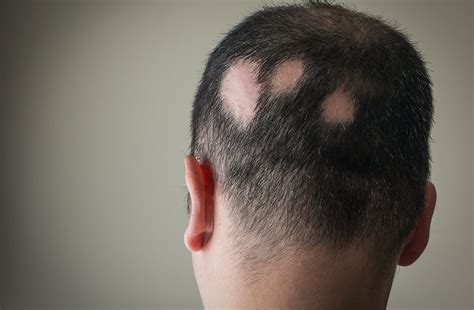Bald head patches, medically known as alopecia areata, are characterized by the sudden appearance of round, smooth patches of hair loss on the scalp. While the condition can be distressing, it is generally not harmful and often resolves on its own within a year. However, for some individuals, it can be a persistent issue, leading to significant emotional and psychological distress.

Prevalence and Impact
According to the National Alopecia Areata Foundation, approximately 6.6 million Americans are affected by alopecia areata, with an estimated 2% of the global population experiencing the condition at some point in their lives. The condition typically affects both men and women equally, and can occur at any age, although it is most common in adolescents and young adults.
Causes
The exact cause of alopecia areata is unknown, but it is believed to be an autoimmune disorder, in which the body’s immune system mistakenly attacks the hair follicles, causing them to shrink and stop producing hair. This autoimmune response may be triggered by a combination of genetic and environmental factors, such as:
- Genetics: Family history of alopecia areata increases the risk of developing the condition.
- Stress: Emotional or physical stress has been linked to the development or exacerbation of alopecia areata.
- Certain medical conditions: Conditions such as thyroid disease, lupus, and diabetes can increase the risk of developing alopecia areata.
- Medications: Some medications, such as chemotherapy drugs and certain antidepressants, can causetemporary hair loss that may mimic alopecia areata.
Symptoms
The primary symptom of alopecia areata is the sudden appearance of one or more round, smooth patches of hair loss on the scalp. These patches can range in size from a quarter to several inches in diameter and typically have well-defined borders. In some cases, the hair loss may be preceded by itching or burning of the scalp.
Diagnosis
The diagnosis of alopecia areata is usually made based on a physical examination of the scalp and the patient’s medical history. A doctor may also order a blood test or a scalp biopsy to rule out other possible causes of hair loss.
Treatment Options
There is no cure for alopecia areata, but treatments are available to help stimulate hair growth and manage the condition. Treatment options may include:
- Medications: Topical or oral medications, such as minoxidil or finasteride, can help to promote hair growth.
- Immunotherapy: This treatment involves injecting an allergen into the scalp to trigger an immune response that may help to suppress the autoimmune attack on the hair follicles.
- Corticosteroids: These medications can help to reduce inflammation and suppress the immune response.
- Laser therapy: Low-level laser therapy may stimulate hair growth and reduce inflammation.
- Platelet-rich plasma (PRP) therapy: This treatment involves injecting PRP into the scalp to promote hair growth.
Prevention
There is no known way to prevent alopecia areata, but managing stress and maintaining a healthy lifestyle may reduce the risk of developing the condition.
Emotional and Psychological Impact
Bald head patches can have a significant emotional and psychological impact on individuals, particularly those who are self-conscious about their appearance. The condition can lead to feelings of embarrassment, shame, and isolation. It can also affect self-esteem and confidence.
Support and Resources
For individuals affected by alopecia areata, there are a number of support groups and resources available, such as:
- The National Alopecia Areata Foundation (NAAF)
- The Alopecia World Alliance (AWA)
- The International Society of Hair Restoration Surgery (ISHRS)
These organizations provide information, support, and advocacy for individuals with alopecia areata.
FAQs
1. Is alopecia areata contagious?
No, alopecia areata is not contagious. It is an autoimmune disorder that affects the hair follicles.
2. Can alopecia areata lead to complete hair loss?
In most cases, no. Alopecia areata typically causes patchy hair loss. However, in some cases, it can lead to more extensive hair loss, including total hair loss (alopecia universalis) or loss of all body hair (alopecia totalis).
3. Is there a cure for alopecia areata?
Currently, there is no cure for alopecia areata. However, there are treatments available to help stimulate hair growth and manage the condition.
4. Can alopecia areata affect other areas of the body?
Alopecia areata can affect any hair-bearing area of the body, including the scalp, eyebrows, eyelashes, and body hair.
5. Is alopecia areata hereditary?
There is a genetic component to alopecia areata, but it is not always inherited. Family history of the condition increases the risk of developing it, but many people with alopecia areata do not have a family history of the condition.
6. Can stress cause alopecia areata?
Stress is a known trigger for alopecia areata. Emotional or physical stress can lead to the development or exacerbation of the condition.
7. Can alopecia areata be reversed?
In most cases, alopecia areata is a temporary condition that resolves on its own within a year. However, for some individuals, it can be a persistent issue. Treatments are available to help stimulate hair growth and manage the condition, but there is no guarantee that hair will regrow completely.
8. What are the emotional and psychological effects of alopecia areata?
Bald head patches can have a significant emotional and psychological impact on individuals, particularly those who are self-conscious about their appearance. The condition can lead to feelings of embarrassment, shame, and isolation. It can also affect self-esteem and confidence.
